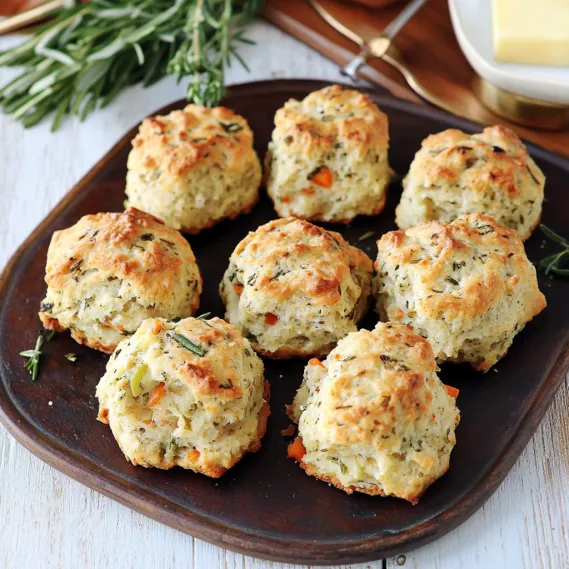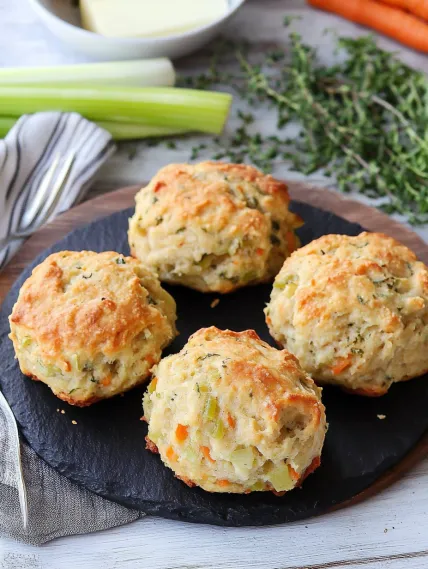 Pin it
Pin it
This savory stuffing biscuit recipe combines all the comforting flavors of traditional Thanksgiving stuffing in a convenient, portable form. The biscuits capture the essence of holiday meals with aromatic herbs and vegetables folded into a buttery, flaky dough that bakes up golden and delicious. Perfect for satisfying stuffing cravings any time of year without cooking an entire turkey dinner.
I created these biscuits after a particularly memorable Thanksgiving when we had mountains of leftover turkey but ran out of stuffing too quickly. Now my family requests these biscuits year round, and they've become our special tradition for Black Friday breakfast, slathered with cranberry sauce and topped with leftover turkey.
Ingredients
- Celery: Finely chopped for that classic stuffing flavor and slight crunch
- Onion: Adds aromatic sweetness that develops while cooking
- Carrots: Provide subtle sweetness and beautiful color throughout the biscuits
- Fresh thyme: Brings woodsy evergreen notes essential to traditional stuffing
- Fresh sage: Offers earthy flavor that pairs perfectly with poultry
- Bread flour: Creates structure for fluffy yet sturdy biscuits
- Buttermilk: Ensures tender crumb and slight tanginess
- Unsalted butter: Provides richness and creates flaky layers
- Fresh rosemary: In the glaze adds aromatic finish and visual appeal
How To Make Stuffing Biscuits
- Prepare the vegetable mixture:
- Process celery, onion, carrots, thyme, sage, salt and pepper in food processor until very finely chopped but not pureed. This creates even distribution of vegetables throughout each biscuit and allows them to cook quickly.
- Sauté the aromatics:
- Cook the processed vegetable mixture in olive oil over medium heat for 10 to 12 minutes. This crucial step develops deep flavor as the vegetables caramelize slightly and their moisture reduces. Allow to cool completely before adding to biscuit dough.
- Mix the dry ingredients:
- Thoroughly combine bread flour, baking powder, baking soda, sugar and salt in a large bowl. The bread flour provides extra structure to support the vegetable additions while still yielding tender biscuits.
- Combine wet ingredients:
- Whisk together buttermilk and half the melted butter until fully incorporated. The buttermilk activates the leavening agents while adding pleasant tanginess.
- Create the dough:
- Pour wet ingredients into dry ingredients and stir just until a shaggy dough forms. Fold in cooled vegetable mixture gently until evenly distributed. Overmixing will develop too much gluten and create tough biscuits.
- Shape and bake:
- Drop generous spoonfuls of dough onto baking stone, creating 12 rustic biscuits. Bake initially for 12 minutes until beginning to set.
- Apply herb butter finish:
- Mix remaining melted butter with fresh chopped rosemary and brush generously over partially baked biscuits. Return to oven for 6 to 8 additional minutes until golden brown and fully cooked.
 Pin it
Pin it
The fresh sage in this recipe transforms these from ordinary biscuits into something truly special. My grandmother always kept a sage plant by her kitchen door, and the first time I made these biscuits, the aroma took me right back to her kitchen during holiday meal preparations. The earthy, slightly peppery flavor of fresh sage creates that unmistakable stuffing essence that makes these biscuits irresistible.
Make Ahead Instructions
These stuffing biscuits can be prepared completely and frozen for up to three months. Simply cool completely after baking, wrap individually in plastic wrap, and store in freezer bags. To reheat, thaw overnight in the refrigerator and warm in a 325°F oven for 10 minutes or until heated through. For best results, apply a fresh brush of melted butter after reheating to restore moisture and shine.
Creative Serving Ideas
While delicious on their own with a pat of butter, these versatile biscuits truly shine when paired creatively. Split and top with poached eggs and hollandaise for an elevated breakfast. Use as the base for miniature versions of Thanksgiving dinner by layering with turkey, cranberry sauce, and gravy. Create appetizer bites by topping with cream cheese and a small piece of crispy bacon. For an elegant presentation, arrange on a platter with various compound butters flavored with herbs, honey, or citrus zest.
 Pin it
Pin it
Ingredient Substitutions
No buttermilk available? Create a quick substitute by adding one tablespoon of lemon juice or white vinegar to regular milk and letting it sit for five minutes before using. All purpose flour works in place of bread flour but will produce a slightly less structured biscuit. Dried herbs can replace fresh at a ratio of one teaspoon dried to one tablespoon fresh. For a vegetarian gravy option to serve alongside, simmer vegetable broth with sautéed mushrooms, then thicken with a roux of butter and flour for an umami rich topping.
Frequently Asked Questions
- → Can I prepare the vegetable mixture in advance?
Yes, you can prepare the vegetable mixture up to a day in advance. Store it in an airtight container in the refrigerator until ready to mix with the dough.
- → Can I use gluten-free flour for this recipe?
Yes, you can substitute gluten-free flour. Choose a 1-to-1 gluten-free baking flour for the best texture and results.
- → What other herbs can I use if I don’t have fresh thyme or sage?
You can use dried thyme and sage or substitute fresh parsley, oregano, or a poultry seasoning blend for a similar flavor profile.
- → How should I store leftover biscuits?
Store leftover biscuits in an airtight container at room temperature for up to 2 days, or refrigerate for up to 5 days. Reheat in the oven for the best texture.
- → Can I freeze these biscuits?
Yes, you can freeze the biscuits. Wrap them tightly in plastic wrap and store in an airtight freezer bag for up to 3 months. Reheat in the oven before serving.
- → What’s the best way to serve these biscuits?
These biscuits are versatile—serve them with butter, cranberry sauce, or gravy. They're also fantastic for making sliders with Thanksgiving leftovers like turkey and stuffing.
